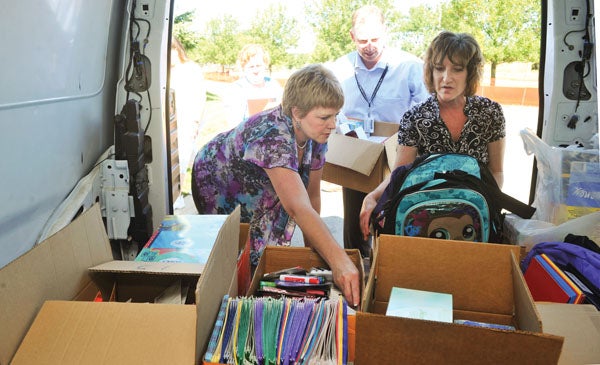Back to the costly grind
Published 8:00 am Wednesday, August 31, 2011

Sharon Alms, superintendents secretary, adjusts school supplies collected by the Hormel plant's Employee Enrichment Committee Thursday. Rising school costs have made donations from organizations welcome each school year. - Eric Johnson/photodesk@austindailyherald.com
It’s no surprise that in tough economic times, back-to-school supplies cost more. What is surprising is how much people and schools are suffering from the effects.
A frugal mind-set is one many back-to-school shoppers across the nation are using as they head out to make purchases, according to a release from the National Retail Federation (NRF).
Parents are having their children survey their closets to take inventory of what’s really needed before making their back to school lists, said NRF President and CEO Matthew Shay in a release.
“Retailers understand consumers are extremely focused on value and are taking this opportunity to offer substantial savings on merchandise,” he said.
According to NRF’s 2011 Back-to-School survey conducted by BIGresearch, families with children in kindergarten through 12th grade will spend an average of $603.63 on apparel, school supplies and electronics, within a few dollars of last year’s $606.40 average.
In addition, retailers are raising prices on merchandise an average of 10 percent across-the-board this fall in an effort to offset their rising costs for materials and labor. But merchants are worried that cash-strapped customers who are weighed down by economic woes will balk at price hikes. So, retailers are trying to raise prices without tipping off unsuspecting customers.
It seems to be working, as local residents are paying what they can for supplies and clothing.
“The kids need them anyway,” said Kim Baier.
Juan Cartera agrees. The second-year Riverland Community College student spent about $400 on textbooks alone this year. He’s taking plenty of general education courses while pursuing a Law Enforcement degree. He was surprised by how expensive books were this year. He won’t try to sell his books back, as he doesn’t believe he’ll get even close to his money back. He’s content to keep his books, however.
“We need them, and we’ll obviously do whatever it takes (to get them),” Cantera said.
Sam Scheffler agrees. He’s going into Riverland’s wind turbine technician program and aside from $556 in textbooks, he also spent about $150 on equipment he’ll need.
“You’re going to always be looking back at your resources,” he said.
It’s not just students feeling the pinch, however. Teachers are footing the bill for supplies too.
“I spend a lot,” said Erin Schoen, Southgate Elementary School teacher. When she switched from special education to a general classroom last year, she spent about $800 on classroom supplies (out of her pocket) to be ready for the school year. She’s already spent about $300 for supplies, on her own, and anticipates more costs ahead.
Tracy Braaten knows the feeling. She’s a Southgate second-grade teacher with a 15-year career. She usually spends about $500 “at least” on her classroom throughout a school year.
“I’m sure I’ve spent $150 right now and I’m still spending on my own kids,” Braaten said.
What’s more, schools are facing rising costs across the board, but especially in the cafeteria.
As part of the Healthy Hungree-Free Kids Act passed last year, school districts are required to raise their lunch fees if lunches were less than $2.50.
“If your prices were under $2.50, you were required to raise your prices by at least 5 cents,” said Mary Weikum, director of food and nutrition at Austin Public Schools.
That’s why the Austin school board raised breakfast costs by 5 cents and lunch will increase by 10 cents. The proposed measure won’t affect free and reduced lunch prices. Weikum said Austin’s prices, which hover around $2 for lunch, are among the lowest in the Big 9 conference.
The increased costs are meant to off-set federal money given to districts for free and reduced lunches. Those costs could help with increased food prices, specifically dairy and grains. Though Austin’s grain contract only had a 4 percent increase this year, Austin’s dairy contract costs increased by 11 percent.
“We did budget also for this kind of thing,” Weikum said. “We hope to break even, like every year.”
Many schools are working towards updating their food offerings as well, since federal mandates for healthier food will take effect next year. Yet districts still have to comply with current guidelines, which means educators will have to make drastic adjustments next year to their budgets.
“Even if we were proactive and using the new standards that we could see in the year, we could get dinged on our audit,” Weikum said.
—The Associated Press contributed to this report.





